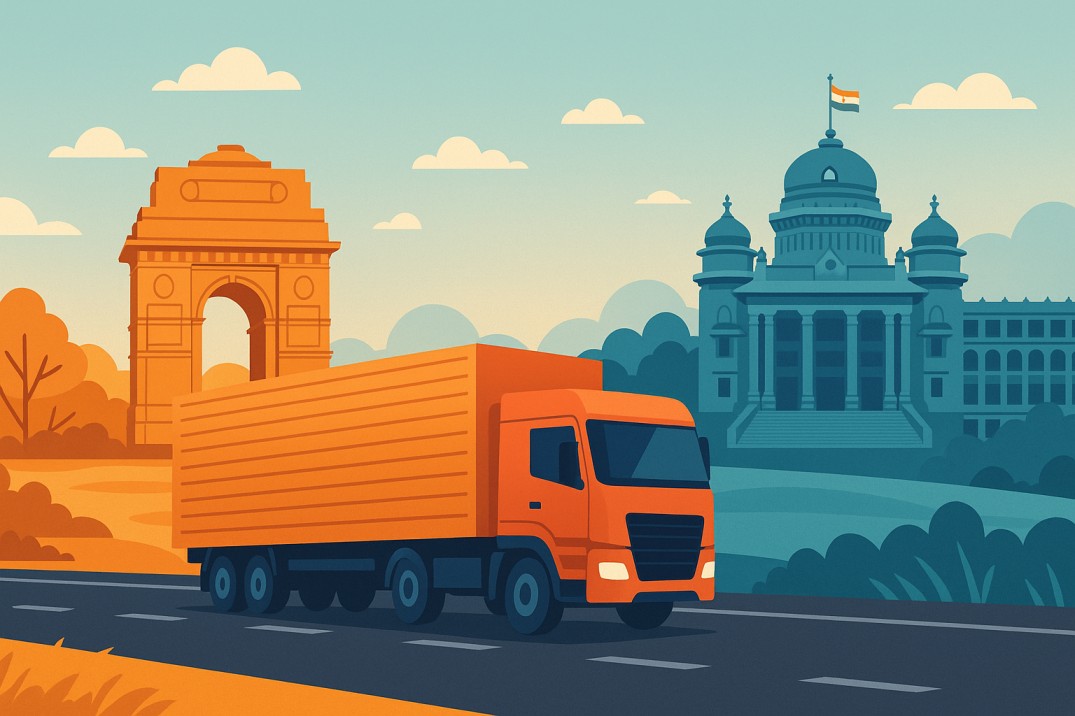
The Delhi to Bengaluru Transport Service stands as a vital lifeline within India’s logistics ecosystem, connecting two of the nation’s largest economic centers — the industrial capital of North India and the technology hub of the South.
Based on Trukky’s booking data from the past six months, this report uncovers freight trends, material movement, pricing patterns, and operational insights that define one of India’s most active long-haul corridors.
How Was This Study Conducted? – Insights from Trukky’s Booking Data
As one of India’s leading spot logistics platforms, Trukky’s digital ecosystem captures thousands of freight bookings across routes daily.
By analyzing six months of booking data, including shipment types, truck utilization, and customer behavior, Trukky’s analytics team provides deep insights into the Delhi to Bengaluru Transport Service — revealing not just what moves, but how efficiently it moves across 2,100+ km of India’s highway network.
Market Size: How Big Is the Delhi–Bengaluru Freight Corridor?
According to Trukky’s market intelligence (2025), road freight between Delhi and Bengaluru represents a logistics market valued at INR 1,800–2,000 crore annually.
This corridor accounts for a substantial portion of India’s long-haul cargo, connecting Delhi NCR’s industrial base with Bengaluru’s IT and manufacturing zones. Notably, Small and Medium Enterprises (SMEs) contribute nearly 40% of total freight volume, highlighting their pivotal role in sustaining the corridor’s economic activity.
Top 10 Commodities Transported from Delhi to Bengaluru
| Rank | Material Type | Common Use |
|---|---|---|
| 1 | Electronics & Appliances | Consumer and B2B electronics |
| 2 | Textiles & Garments | Apparel and fashion supply chains |
| 3 | Industrial Machinery | Capital goods and factory equipment |
| 4 | Pharmaceuticals | Medical and healthcare shipments |
| 5 | Automotive Parts | OEM and aftermarket supplies |
| 6 | Furniture | Residential and commercial interiors |
| 7 | Food Products | Packaged and perishable items |
| 8 | Construction Materials | Cement, tiles, steel |
| 9 | Chemicals | Industrial and specialty chemicals |
| 10 | Consumer Goods | FMCG and retail distribution |
These diverse commodities highlight the multi-sector dependency on the Delhi to Bengaluru Transport Service.
Top 3 Truck Types in Demand for the Route
-
20 Feet Containers – Suitable for electronics, pharma, and machinery.
-
32 Feet Multi-Axle Trucks – Preferred for FMCG and bulk retail cargo.
-
LCV / Load Sharing Trucks (1–5 Ton) – Ideal for part-load and SME freight.
Each truck category caters to a distinct freight profile, allowing optimized loading, cost efficiency, and reliability for both short and long-haul needs.
What Factors Influence Road Freight Rates Between Delhi and Bengaluru?
Freight pricing on this corridor is dynamic, influenced by multiple operational and external variables:
-
Fuel Prices: Any rise in diesel costs directly impacts per-kilometer freight rates.
-
Demand–Supply Dynamics: During festive or fiscal closing months, increased demand drives temporary rate hikes.
-
Seasonality: High seasons (October–February) often see higher rates; monsoons typically moderate prices.
-
Load Type & Weight: Heavy or ODC (Over-Dimensional Cargo) loads attract specialized pricing.
Hence, businesses using Trukky benefit from real-time rate discovery, helping them book trucks at transparent, data-backed prices.
Delhi to Bengaluru Freight Rate Table (2025)
| Truck Type / Category | Tentative Rate (₹) | Use Case |
|---|---|---|
| Load Share | ₹10–₹12/kg | Part Load / Shared Consignments |
| Mini Truck (1–2 Ton) | ₹35,000 – ₹40,000 | Light Cargo, SME Deliveries |
| LCV (3–8 Ton) | ₹48,000 – ₹58,000 | FMCG, Electronics |
| Medium Truck (10–15 Ton) | ₹75,000 – ₹1,05,000 | Industrial Goods |
| Taurus (19–38 Ton) | ₹5,500 – ₹4,200 / ton | Bulk or Heavy Freight |
| ODC & Trailer | ₹1,10,000 – ₹1,45,000 | Machinery / Oversized Cargo |
Data Reference – Trukky Freight Analytics, 2025
What Is the Preferred Route and Transit Time?
The primary trucking route for the Delhi to Bengaluru Transport Service follows NH 44, one of India’s longest and busiest national highways.
Preferred Route:
Delhi → Agra → Gwalior → Jhansi → Nagpur → Hyderabad → Bengaluru
-
Total Distance: ~2,100 km
-
Transit Time: 4–5 days (depending on load type, shipment category, and driver schedules)
Smooth connectivity through Nagpur’s central corridor and Hyderabad’s logistics parks ensures consistent fleet availability throughout the year.
How Trukky Delivers Excellence on the Delhi–Bengaluru Route
With a mission to simplify India’s logistics through technology, transparency, and trust, Trukky’s platform provides shippers with end-to-end digital control over their consignments.
Key Advantages
-
⚙️ Instant Price Discovery: Access live freight pricing across multiple truck types.
-
🛰️ Real-Time Tracking: Monitor shipment progress using GPS-integrated systems.
-
🚛 Reliable Fleet Network: Thousands of verified trucks, from mini-loads to trailers.
-
🧾 Digital Documentation: Upload LR, POD, and invoices instantly through the Trukky dashboard.
-
🤝 Trusted TAP Partners: Operational excellence through Trukky Associate Partner Network across all major routes.
Trukky ensures that every freight movement between Delhi and Bengaluru is optimized for time, cost, and transparency.
Conclusion
The Delhi to Bengaluru Transport Service continues to serve as a backbone of India’s long-haul road logistics.
With a market size exceeding ₹1,800 crore and thousands of shipments every month, the corridor connects industries, technology, and trade like no other.
Leveraging Trukky’s intelligent freight systems, businesses can unlock real-time rates, verified transport partners, and live tracking — ensuring shipments arrive on time, every time.
If you are looking for a transport service in Delhi, transport service in Bengaluru, or simply a transport service near me, Trukky is your go-to platform for a smarter, transparent, and data-driven logistics experience.
“At Trukky, every kilometer we cover brings India’s businesses closer together.”


